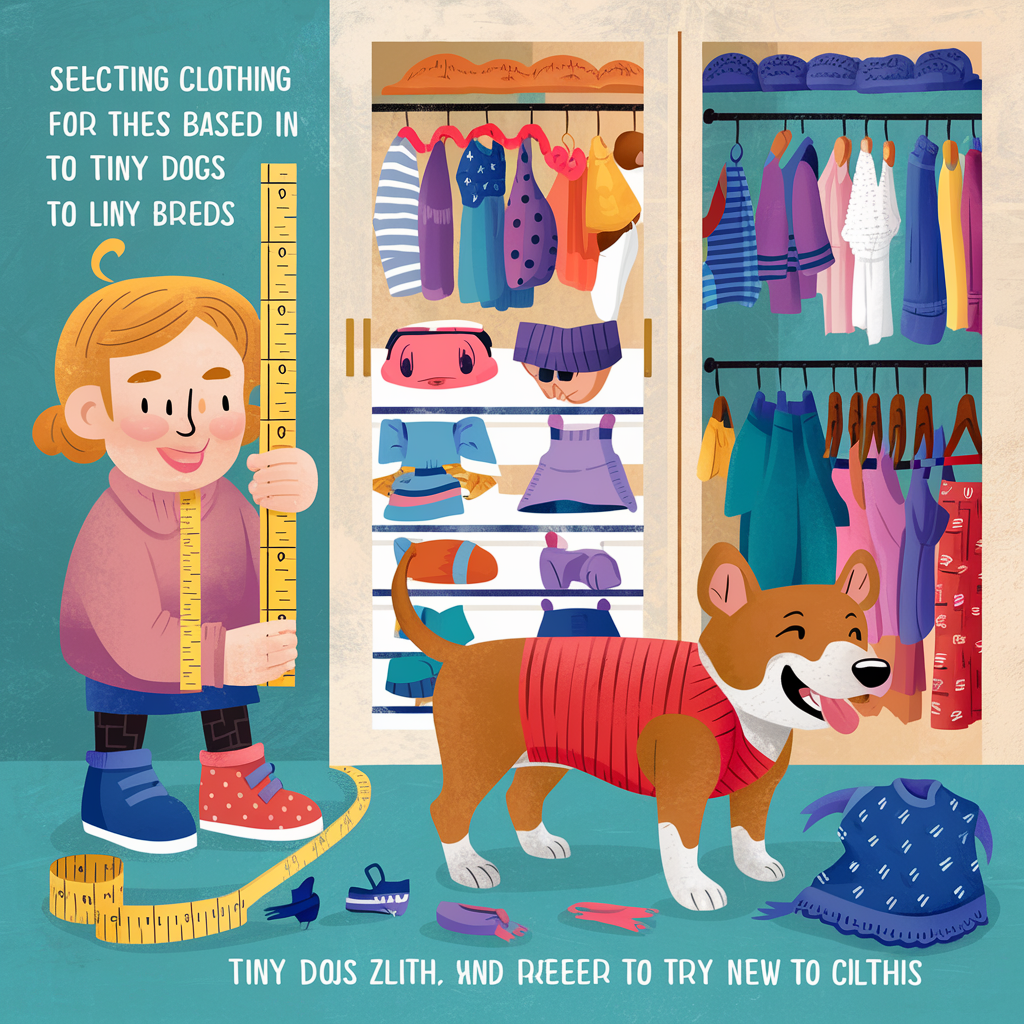Finding the perfect fit when it comes to dressing your furry friend can be as challenging as it is essential. With dog clothes ranging from everyday sweaters to functional coats and stylish jackets, understanding how to measure dog height is the first step towards ensuring a comfortable and secure fit. This process not only enhances your dog’s comfort but also elevates their style, making every walk a fashion statement. Whether dealing with small dogs or large dogs, the importance of a properly fitting garment cannot be overstated, as it directly impacts the pet’s ease of movement and overall well-being.
This article will guide you through a step-by-step process of using a measuring tape to capture the precise dimensions of your dog, focusing on crucial areas such as the withers and the body length. From interpreting a size chart to selecting the ideal dog sweaters, coats, and accessories based on these measurements, you will learn how to ensure an optimal clothing fit. Additionally, the piece will cover the nuances of sizing guide variations among different dog breeds, providing tips on measuring the length accurately for everything from dog jackets to casual wear. By the conclusion, readers will be well-equipped with the knowledge to make informed decisions regarding dog accessories and clothes, ensuring both style and comfort for their canine companions.

How to Measure Dog
The Importance of Properly Fitting Dog Clothes
Properly fitting dog clothes are essential not only for style but also for the health, hygiene, and safety of canines. High-quality garments tailored for dogs can enhance their comfort and provide additional benefits like warmth in cold weather and cooling in hot temperatures 1. Especially for small dogs or those with health conditions, maintaining an optimal body temperature is crucial, which can be effectively managed with the right clothing 1.
For dogs that are exposed to harsh weather conditions, a well-fitted jacket acts as a protective barrier against rain, wind, or snow, which is particularly important for breeds with thin coats or sensitive skin 2. Additionally, clothing like dog pajamas and recovery suits play a vital role in post-surgical care by preventing dogs from licking or chewing at healing wounds, thereby minimizing infection risks and promoting faster recovery 2.
Moreover, dog clothes can offer protection from external parasites such as ticks and fleas, especially in environments where these pests are prevalent. By covering the dog’s body, clothes can deter bugs from biting or residing in their fur 1. This is further supported by the use of reflective materials in dog outfits, which enhance visibility during nighttime, thereby reducing the risk of accidents 1.
Another practical aspect of dog clothes is their ability to contain loose fur, which helps in maintaining cleanliness both at home and in breeding facilities. This is particularly advantageous for owners who wish to reduce the amount of pet hair in their environment 2.
In summary, ensuring that dog clothes fit properly is not just about esthetics but is a multifaceted approach to enhancing a dog’s quality of life. It is important to measure dogs accurately and select clothes that offer a snug, yet comfortable fit to avoid issues like restricted movement or the risk of clothes getting caught, which could lead to discomfort or injury 3.
Step-by-Step Guide to Measuring
Preparing Your Dog
Before starting the measurement process, gather all necessary items: a soft measuring tape and some treats to keep your dog calm and cooperative 4. Ensure your dog is standing in a natural position and is relaxed. This will make the measuring process easier and more accurate.
Measuring Neck Circumference
To measure your dog’s neck, wrap the measuring tape around the base of the neck, just above where the neck joins the shoulders 5. This is typically where a collar would sit. The tape should be snug but ensure you can still slip two fingers between the tape and your dog’s neck, ensuring it’s not too tight 4 5.
Measuring Chest Circumference
The chest circumference is critical for a proper fit. Wrap the measuring tape around the widest part of your dog’s chest, which is usually just behind the front legs 6 4 5. It’s important to make sure the tape is snug but not tight. The ‘two-finger rule’ should also apply here, allowing for a comfortable fit without restricting your dog’s movement.
Measuring Body Length
Finally, measure your dog’s body length. Have your dog stand and measure from the base of the tail to the bottom of the collar, which is typically where the neck meets the shoulders 4. This measurement helps in selecting the correct length for items like coats and sweaters, ensuring they cover the necessary body parts without hindering movement.
By following these steps, you can accurately measure your dog to ensure a perfect fit for various types of clothing and harnesses, enhancing both comfort and functionality.
Choosing the Right Clothes Based on Measurements
Using Manufacturer’s Size Charts
When selecting the right clothes for your dog based on measurements, it is crucial to utilize manufacturer-provided size charts. These charts often detail the measurements needed for different types of gear, such as sweaters, jackets, and harnesses. It’s important to follow these guides closely as each brand may have slight variations in sizing 7 8. For instance, a dog’s chest girth is typically the most critical measurement for clothing fit, as it ensures the garment is neither too tight nor too loose 9 10. Manufacturers recommend using the chest girth as the primary guide, followed by the length from the base of the collar to the base of the tail to determine the appropriate size 7 8.
Adjustments for Different Types of Clothes
Different types of dog clothes may require specific adjustments. For example, when choosing clothes that do not have a cutout for the male dog’s groin and belly, it might be necessary to shorten the length to prevent the dog from urinating on the clothes 6. Additionally, for breeds with unique body shapes, like Greyhounds, adjustments in the chest and neck measurements are crucial to ensure a comfortable fit 7. When dealing with sweaters and jackets, it’s also essential to consider the neck girth to ensure the neck hole is large enough to be comfortable, yet secure 8.
In summary, accurate measurement and careful consideration of the specific clothing type and breed characteristics are key to choosing the right dog clothes. Always refer to the specific size charts provided by the manufacturers and make adjustments as necessary to ensure a perfect fit.
Ensuring Comfort and Fit
Double-Checking Measurements
To ensure the utmost comfort and fit for dog clothes, it is crucial to double-check the measurements before making a purchase. This involves revisiting the measurements of the dog’s neck, chest, and body length. Accuracy at this stage helps prevent discomfort that could arise from clothes that are too tight or too loose, which can restrict movement or even pose safety risks.
Trying on Multiple Sizes if Necessary
If possible, trying on multiple sizes can be a beneficial step. This allows the owner to compare how different sizes fit their dog, ensuring that the chosen clothes do not hinder the dog’s ability to move freely. It is particularly important when shopping from brands for the first time, as sizing can vary significantly between different manufacturers.
Adjusting Clothes Correctly
Once the best size is selected, proper adjustment of the clothes is essential. This may include tightening straps or rolling sleeves to prevent tripping or entanglement. Ensuring that any closures are secure but not restrictive will enhance the dog’s comfort and safety. This careful adjustment helps accommodate the dog’s specific body shape and size, promoting ease of movement and preventing any potential mishaps during wear.
Conclusion
Throughout this article, we have navigated the intricate process of measuring a dog for perfectly fitting clothes, illustrating the importance of precise measurements for the health and style of our canine companions. From neck circumference to chest girth and body length, we emphasized the critical steps needed to ensure comfort, protection, and mobility in a variety of clothing options. The discussions highlighted not only the practicality of well-fitted garments in safeguarding against weather extremities and potential injuries but also their role in expressing a dog’s unique style and personality.
As we conclude, remember that the journey to finding the perfect fit for your furry friend requires patience, attention to detail, and an understanding of their specific needs based on breed, size, and health conditions. By utilizing the guide provided, dog owners are well-equipped to make informed decisions that prioritize their pet’s comfort and well-being. Embracing these practices not only enhances the quality of life for our pets but also strengthens the bond we share with them, proving that the right fit in clothing can indeed make every journey together more enjoyable and stylish.
FAQs
Q: How should I measure my dog’s height accurately?
A: To accurately measure your dog’s height, measure from the floor to the highest point of the shoulder blades. Use a pencil or removable tape to mark this point on a measuring stick or against a wall for an accurate reading.
Q: What is the method for measuring a dog’s body length and chest for clothing?
A: To measure your dog’s body length, start at the base of the neck between the shoulder blades and extend the measuring tape to the base of the tail. For the chest measurement, wrap the tape measure around the deepest part of the dog’s chest, typically right behind the front legs. Additionally, measure the entire width of the chest from the front to determine the chest width.
Q: How is a dog’s height measured for AKC purposes?
A: When measuring a dog’s height for the American Kennel Club (AKC), use your left hand to find the highest point of the withers without touching the dog elsewhere. Position the measuring device known as a wicket from behind the dog, moving it forward to the withers. Ensure both legs of the wicket fully contact the ground or table and the crossbar touches the withers for a precise measurement.
Q: What size human clothes might fit my dog?
A: Human children’s clothing sizes tend to fit dogs well, except for the very largest breeds. For instance, a medium-sized, barrel-chested pit bull mix might comfortably wear a size Large (7-8) in children’s clothing sizes.
References
[1] – https://pridebites.com/blogs/barking-post-blog/5-reasons-why-dog-clothes-are-important
[2] – https://richmondmom.com/7-benefits-of-dog-clothing-for-small-breeds/
[3] – https://www.akc.org/expert-advice/advice/dog-clothes-weather-safety/
[4] – https://be.chewy.com/how-to-measure-your-dog-for-clothes-because-you-know-you-want-to-dress-up-your-pup/
[5] – https://www.youtube.com/watch?v=aCEvYN_HqC4
[6] – https://shop.akc.org/pages/the-ultimate-dog-apparel-measuring-guide
[7] – https://www.petstock.co.nz/blog/articles/understanding-dog-sizing-charts-and-how-to-fit-clothing
[8] – https://www.bowlandbone.com/how-to-choose-the-right-size-of-dog-clothes/
[9] – https://www.funnyfur.com/how-to-measure-size-guide/
[10] – https://www.doginthecloset.com/size-charts/
Dog Care

